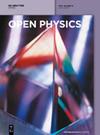利用密度泛函理论研究取代基对新设计的吡咯衍生物的电子和光学特性的影响
IF 1.8
4区 物理与天体物理
Q2 PHYSICS, MULTIDISCIPLINARY
引用次数: 0
摘要
这项研究探讨了通过对 2,5-二(2-噻吩基)吡咯分子进行多次取代而获得的六种新设计化合物。对于这一系列化合物,我们使用密度泛函理论和时间相关密度泛函理论(TD-DFT)研究了它们的电子和光学性质。通过计算与其光学和电学性质相关的化学参数,对新化合物进行了表征。利用 6-311G (d, p) 基集的 B3LYP 函数计算了最低未占分子轨道(LUMO)和最高已占分子轨道(HOMO)的能量。发现 Perr-NO2 的 LUMO 能级最低,这表明它具有有效的电子注入能力和抗氧化性。Perr-Cl 和 Perr-NO2 的 HOMO 和 LUMO 分布在这两种化合物的每个成分中都显示出显著的互补性,表明分子间电荷转移非常有效。分子静电位分析表明,所提出的化合物具有广泛的亲电和亲核位点分布,这预示着化合物具有很高的化学反应活性。利用电子定位功能和局部轨道定位器技术对标题化合物成键和反成键位点的电子密度进行了分析。利用密度梯度还原法进行的非共价相互作用分析对所有类型的相互作用进行了分类:化合物片段内的排斥性相互作用、弱相互作用和吸引性相互作用。紫外/可见(UV/vis)光谱是利用 CAM-B3LYP 模型结合 6-311G (d, p) 基集和甲醇作为溶剂通过 TD-DFT 获得的,在紫外范围内发现了吸收带,并且最大波长出现了红移增加。这些化合物可作为一种基础材料,用于开发具有大量紫外线/可见光吸收(180-400 纳米)的选择性气体传感器。研究结果表明,所设计的化合物具有高导电性和光化学性质,是光电和传感器应用领域聚合物设计前体的良好候选材料。本文章由计算机程序翻译,如有差异,请以英文原文为准。
Substituent effect on the electronic and optical properties of newly designed pyrrole derivatives using density functional theory
This work explores six newly designed compounds obtained by several substitutions in 2,5-di(2-thienyl) pyrrole molecule. For this series of compounds, the electronic and optical properties were investigated using density functional theory and time-dependent density functional theory (TD-DFT). The new compounds were characterized by calculating the chemical parameters that correlated with their optical and electrical properties. The lowest unoccupied molecular orbital (LUMO) and the highest occupied molecular orbital (HOMO) energies are calculated using the B3LYP functional with the 6-311G (d, p) basis set. The most low-lying energy level of the LUMO was found for Perr-NO2 , indicating its effective electron injection capabilities and oxidation resistance. The HOMO and LUMO distributions of Perr-Cl and Perr-NO2 displayed a remarkable complementarity throughout each component of the two compounds, indicating an effective intermolecular charge transfer. The molecular electrostatic potential analysis demonstrated that the proposed compounds have a broad distribution of electrophilic and nucleophilic sites, which predict a high degree of chemical reactivity. The electron density analysis at the bonding and anti-bonding sites of the title compounds was performed using the electron localization function and local orbital locator techniques. Non-covalent interaction analysis using the reduced density gradient approach classified all types of interaction: repulsive, weak, and attractive interactions within compound fragments. All compounds exhibited a robust repulsive interaction, as proved by the red spikes at 0.038 a.u. The ultraviolet/visible (UV/vis) spectrum was obtained by TD-DFT using CAM-B3LYP models in conjunction with 6-311G (d, p) basis set and methanol as a solvent, the absorption bands were found within the UV range, and the maximum wavelength showed red-shifted increases. These compounds could serve as a base material for developing selective gas sensors with considerable UV/vis absorption (180–400 nm). According to the research results, the designed compounds are good candidates for use as precursors in polymer designs for optoelectronic and sensor applications due to their high electrical conductivity and photochemical properties.
求助全文
通过发布文献求助,成功后即可免费获取论文全文。
去求助
来源期刊

Open Physics
PHYSICS, MULTIDISCIPLINARY-
CiteScore
3.20
自引率
5.30%
发文量
82
审稿时长
18 weeks
期刊介绍:
Open Physics is a peer-reviewed, open access, electronic journal devoted to the publication of fundamental research results in all fields of physics. The journal provides the readers with free, instant, and permanent access to all content worldwide; and the authors with extensive promotion of published articles, long-time preservation, language-correction services, no space constraints and immediate publication. Our standard policy requires each paper to be reviewed by at least two Referees and the peer-review process is single-blind.
 求助内容:
求助内容: 应助结果提醒方式:
应助结果提醒方式:


